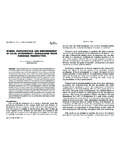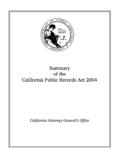Transcription of The Maine Yankee Decommissioning Advisory Panel A …
1 A REPORT BY THE Maine Yankee COMMUNITY ADVISORYPANEL ON DECOMMISSIONINGF ebruary 2005 The Maine Yankee DecommissioningAdvisory PanelA Model for public participation inNuclear ProjectsiThe Maine Yankee Decommissioning Advisory PanelA Model for public participation in Nuclear ProjectsA REPORT BY THE Maine Yankee COMMUNITY ADVISORYPANEL ON DECOMMISSIONINGF ebruary 2005 Prepared and edited byCatherine W. FerdinandBlack Diamond Consultants, of the MaineYankee containmentbuilding took two years tocomplete. The dropping of the dome section usingexplosive demolitionoccurred in September2004. Maine Yankee scontainment dome is thefirst to have been dis-mantled using the explo-sive Of ContentsExecutive SummaryvIntroduction1 Section to Form An Advisory Panel3 Section IIDecision to Form A Community Advisory Panel Charter, Size, Panel and Education of Panel Trust and Successful WorkingRelationships Between the Panel and the Company and Among Panel Information to the Broader Public10 Section IIIA ccomplishments11 Section IVLessons Learned14 Section VRecommendations18 Section VIPerspectives of Individual CAP Marge Donald Hudson, H.
2 Paul Charles P. Pray31 Table Of ContentsivSection VIIP erspectives of Foster, Lincoln County Kalish, Times Boynton, Wiscasset Newspaper32 Section VIII Epilogue33 AppendicesAttachment 1:Original CAP Charter 8/9735 Attachment 2:Revised CAP Charter 11/0239 Attachment 3:Sample public Notice of Meeting43 Attachment 4: Decommissioning /CAP Milestone Chart44 Attachment 5:Draft CAP on Spent Fuel Storage &Removal Charter47 Attachment 6:CAP members - Past & Present51 Table Of ContentsvExecutiveSummaryExecutive SummaryWhen the Maine Yankee nuclear power plant closed prematurely in1997 after 25 years of operation, only two other commercialnuclear facilities had opted to decommission by prompt dismantlement.
3 Whilethe plant s operating history had been one of successful low-cost, reliablegeneration, the two years preceding its closure were marked by unscheduledoutages, increased regulatory scrutiny, and considerable media attention. Giventhe significant negative economic impact of the plant s closure to the localcommunity of Wiscasset and its surrounding towns, and looming questionsabout the future of the 800 plus acre site and the inventory of 1434 spentnuclear fuel assemblies, the company decided to create a new vehicle forcommunication with the public a Panel of community stakeholders that wouldbecome the resident experts on issues related to the plant s 1&2 of the report document the steps taken to form such a panelincluding the mechanics of selecting and educating the members, meetingorganization.
4 Establishing trust with the stakeholder interests, and gettinginformation to the public . Section 3 includes the panels analysis of itsaccomplishments in improving public discussion and comprehension ofdecommissioning issues, in impacting company decisions and in setting anexample for other communities to follow. Additionally, the report in Section 4includes a discussion of lessons learned by the Panel including having a definedrole and staying focused on that role, being open to and respectful of differentperspectives, taking the time necessary to educate and listen, and theimportance of consistency in participation and in meeting regularly.
5 Section 5includes a discussion of the eight recommendations of the Maine YankeeCommunity Advisory Panel for other communities facing any similar challenge be inclusive, educate, pay attention to structure and organization, encouragepublic involvement, maintain media interest, answer all questions, usetechnology and share deciding to compile this report, the group, recognizing that memberscame to the Panel with differing views, experiences and interests, chose to allowpanelists the opportunity to offer their individual perspectives on theCommunity Advisory Panel process. Other stakeholder interests, such as themedia, were also invited to comment.
6 These perspective pieces are included insections 6&7 of the of Wiscasset - thispretty coastal villagewas host to Maine s onlynuclear plant from 1972through its decommis-sioning, completed Yankee Atomic Power Com-pany (MYAPC), a single unit 900megawatt nuclear power plant, in the smallcoastal village of Wiscasset, Maine generatedover 118 billion kilowatt-hours (kWh) ofelectricity from 1972 through 1996 . InAugust 1997, the owners of Maine Yankeeannounced the permanent shutdown of thenuclear power plant, eleven years earlier thanthe expected termination of its operatinglicense. At the time of the plant closing, onlythree nuclear plants in the United States, allrelatively small in scale, had been the wake of the shutdown decision,the company and the community shared anumber of challenges.
7 The communitywrestled with the significant and immediateloss of its tax base, the concerns for the safecleanup of the property, and the loomingquestions of the storage and ultimate disposi-tion of the spent nuclear fuel that wouldremain on site. The company faced thechallenges of an immediate dismantlement ofthe facility in a relatively new For the Decommissioning ofMaine Yankee to be successful, thecompany s ability to satisfy regulators had tobe melded with public confidence in thedecommissioning the plant s final two years ofoperation, constant stakeholder attention hadworked to erode that public Yankee management decided thatsome vehicle for improving the company sdialogue with the local community wasnecessary, whether the plant shut down orcontinuedto theplantclosed,the MaineYankeeCommu-nityAdvisory Panel on Decommissioning (CAP)
8 Was established to enhance open communi-cation, public involvement and education onMaine Yankee Decommissioning issues .(Attachment 1)Over the past seven years the commu-nity has witnessed the removal of compo-nents, the demolition of structures, railshipments of waste and construction of aspent fuel storage facility. Through the CAPprocess, the community and the companytogether have wrestled with issues such asthe final condition of the site, impacts ofspent fuel storage after Decommissioning ,and loss of tax other communities certain to facethe issues of Decommissioning nuclear facili-ties or other commercial or industrial entitiesin the future, the CAP and Maine Yankeewish to share their experiences and perspec-tives on this challenging endeavor.
9 Thisreport documents the rationale for the estab-lishment of the CAP, the process of determin-ing its role and functions, and lessons learnedregarding the CAP process, including interac-tions between the company, state and federalregulators, the media and the Fort St. Vrain, Shoreham, Pathfinder. Nuclear Regulatory Commission, Fact Sheet on Decom-missioning Nuclear Power Plants, March 20032 In 1997, of the other sixteen shutdown power reactors in the United States all but three had beenplaced in SAFSTOR, a condition where the plant is maintained and monitored to allow radioactivity todecay, but actual dismantlement of the facility is delayed to a later time.
10 Two commercial reactors shut-down in 1991 and 1992, Yankee Rowe in Massachusetts, and Trojan in Oregon, had begun decommission-ing activities but had yet to file License Termination Plans for NRC approval. Connecticut Yankee , shutdownin 1996, opted to pursue immediate dismantlement about the same time as Maine , Maine Yankee s hostcommunity is a rural communityalong the Sheepscot River with a populationof about 3700. During plant operations, theEmergency Planning Zone (EPZ), an areawithin a 25 mile radius of the powerplant, included 15 additional towns,spanning two counties. Over 50% of theregional economy is based in service andretail trade industries, much of that insupport of tourism.








